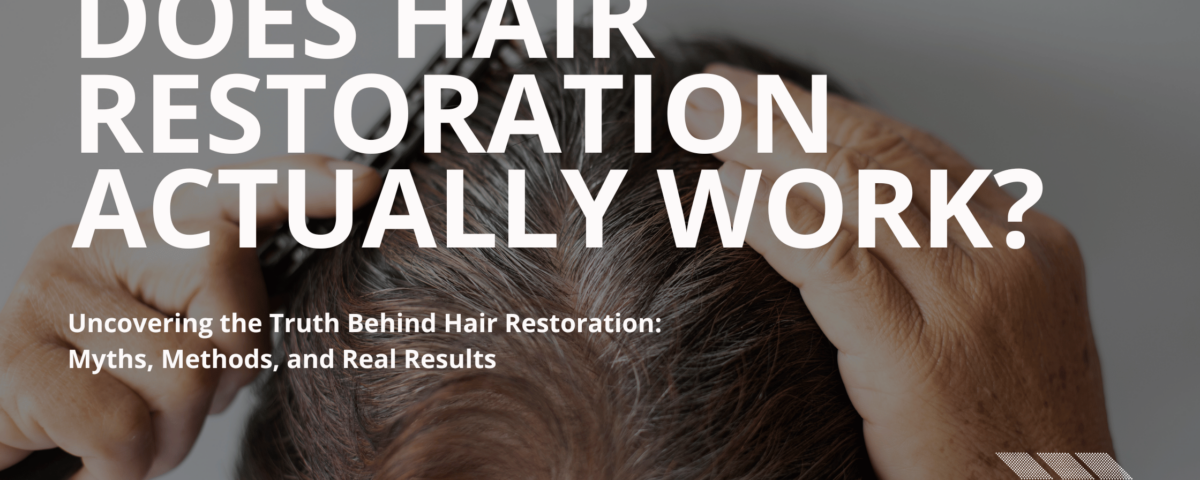
Hair Restoration Quality: Why the USA Leads Over Turkey
November 13, 2024Does Hair Restoration Actually Work?

Hair restoration has become an increasingly sought-after solution for those looking to combat hair loss. With advancements in technology and techniques, it has never been easier to restore a fuller, natural-looking head of hair. However, despite its growing popularity, one question remains: does hair restoration actually work? Many people are understandably skeptical, questioning the effectiveness of these procedures and whether they deliver the results they promise. This blog post will explore how hair restoration works, the success rates of various methods, and why it’s more than just a possibility—it’s a viable solution for lasting hair regrowth.
How Hair Restoration Works
Hair restoration methods have evolved significantly over the years, offering a variety of options for individuals seeking a permanent solution to hair loss. The most popular techniques include FUE (Follicular Unit Extraction), FUT (Follicular Unit Transplantation), and NeoGraft®, each with its own unique approach to hair restoration.
FUE involves the removal of individual hair follicles from a donor area, typically the back of the head, and transplanting them to areas experiencing thinning or balding. This method leaves minimal scarring and offers a more discreet recovery process. FUT, on the other hand, involves removing a strip of skin from the donor area, extracting individual hair follicles from it, and then transplanting them to the target area. While this technique can yield a higher number of grafts in one session, it may result in a linear scar.
NeoGraft® is a newer, advanced version of the FUE technique. It uses a machine-assisted process to extract and transplant hair follicles, which improves precision and reduces recovery time. The automated nature of NeoGraft® allows for a more efficient procedure, minimizing trauma to the scalp and resulting in a quicker healing process for patients.
All these methods work by stimulating natural hair growth. By carefully relocating healthy, permanent hair follicles to thinning or balding areas, hair restoration techniques promote regrowth in these targeted regions. The newly transplanted hair follicles will continue to grow naturally, providing a permanent solution to hair loss.
Success Rates of Hair Transplants
The success of hair transplants is often measured by the long-term effectiveness and the natural appearance of the results. Hair restoration has proven to be a highly successful procedure, with high satisfaction rates among patients. On average, hair transplants yield an 85-95% success rate in terms of graft survival and the regrowth of hair.
NeoGraft®, in particular, stands out with its exceptional outcomes. Patients who undergo NeoGraft® often report significant improvements in both the density and appearance of their hair. With its precision and minimal impact on surrounding tissue, NeoGraft® offers impressive results, with many patients seeing noticeable hair growth within 6 to 12 months after the procedure. The satisfaction rates for NeoGraft® patients are consistently high, thanks to the technique’s ability to deliver natural-looking, lasting results.
However, the success of a hair transplant is influenced by several factors. The quality of donor hair plays a critical role; thicker, denser hair tends to result in more favorable outcomes. The expertise of the surgeon is also essential—an experienced surgeon can carefully assess the patient’s needs, create an individualized treatment plan, and ensure optimal follicle placement for the most natural results. Additionally, patients’ commitment to following post-procedure care instructions can also impact the overall success of the transplant.
In general, the right technique, a skilled surgeon, and proper aftercare lead to the highest rates of success in hair restoration.
Alternatives to Hair Transplants
While hair transplants, particularly NeoGraft®, offer a permanent solution to hair loss, they are not the only option available. For individuals who are not ready for a surgical procedure or prefer a less invasive approach, there are several non-surgical alternatives to consider. These alternatives can help slow down hair loss, promote regrowth, or improve the overall health of the hair, though they may not deliver the same dramatic results as a hair transplant.
One of the most widely used non-surgical treatments is Platelet-Rich Plasma (PRP) therapy. PRP involves drawing a small amount of blood, processing it to concentrate the platelets, and then injecting it into the scalp. The growth factors in the PRP stimulate the hair follicles, promoting healthier, thicker hair growth. While PRP does not offer the same permanent results as a transplant, it can be an effective solution for individuals in the early stages of hair loss, or those looking to enhance the results of a transplant.
Topical treatments, such as minoxidil (commonly known as Rogaine), are also available. Minoxidil can help to slow down hair loss and promote hair regrowth in some individuals. It is typically used for mild to moderate hair thinning, though its effectiveness can vary. For more aggressive hair loss, minoxidil might be less effective, and a surgical solution may ultimately be necessary.
Both PRP and minoxidil can serve as viable alternatives for certain individuals, but they generally require ongoing maintenance and may not provide the same level of lasting results as a hair transplant. In cases where a person seeks a permanent, natural-looking solution, hair transplants remain the most effective and reliable option.
For those unsure of the best path forward, a consultation with a professional team can provide clarity on which treatment is most appropriate based on the degree of hair loss and individual needs.
Conclusion
Hair restoration is a proven, effective solution for those looking to regain a natural-looking head of hair. With techniques like NeoGraft® offering impressive results and high patient satisfaction rates, the possibility of successfully reversing hair loss is more attainable than ever. Whether choosing a hair transplant or exploring non-surgical options like PRP, individuals can find the right solution tailored to their specific needs.
The key to successful hair restoration lies in selecting the appropriate method and working with an experienced professional team. When performed by a skilled surgeon, hair transplants can deliver lasting, life-changing results that go beyond aesthetics to restore confidence and self-esteem.
For anyone considering hair restoration, scheduling a consultation at Advanced Aesthetics of North Texas can provide personalized guidance, helping to determine the best approach for achieving the desired outcome. With the right treatment plan, hair restoration isn’t just possible—it’s a reality.


